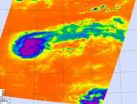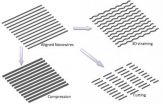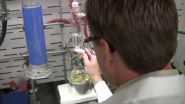(Press-News.org) A study of physics faculty awareness and use of research-based instructional techniques offers greater understanding of what is missing from current education reform efforts
The world has changed dramatically in recent decades but many argue that the university system has not kept pace. As another academic year begins, if you peek into any introductory college science course you're likely to find the same scene as you would have twenty years ago: An instructor writing equations on the blackboard while a lecture hall full of students take notes.
Why is college science instruction so slow to change when we know that there are better methods? Focused research and development has resulted in a variety of effective strategies for teaching science. These techniques typically actively engage students through discussions with classmates, posing and answering questions, and making sense of science concepts. Physics, among all the sciences, has been noted for leading the way in developing such research-based teaching strategies. For example, in one such technique called Peer Instruction the teacher poses challenging questions to students. Students discuss the question with their neighbors, use an electronic device called a "clicker" to vote on the answer, and then the instructor facilitates a whole-class discussion about the question using the real-time feedback from the students' electronic votes.
However, education reformers know very little about just how teaching techniques like Peer Instruction are being used by instructors. A recently released study sheds new light on this critical area. The study, authored by Charles Henderson and Magdalena Niewiadomska-Bugaj of Western Michigan University and Melissa Dancy of the University of Colorado at Boulder, was published in Physical Review Special Topics: Physics Education Research on July 31.
"Nobody had ever done a study like this," said Dr. Henderson. While other researchers have looked at whether faculty do or don't use research-based techniques, Henderson and his colleagues were trying to figure out what types of faculty tend to try these techniques, and whether they keep using them over time.
To accomplish this, the authors used results from a national web survey of 722 physics faculty who had taught introductory physics in the previous two years. Faculty gave information about their background (such as rank, type of institution, gender, and number of research publications). Then, faculty read through a comprehensive set of 24 research-based instructional techniques in physics and indicated whether they had heard of the technique, whether they'd used it, and whether they were still using it. This provided information about where each faculty member stood in the process of choosing whether to use a new teaching approach.
The authors' first finding was that most physics faculty (88% of survey participants) know about at least one of these instructional techniques, and most faculty (72% of participants) had tried at least one. However, faculty who chose to respond to the survey may be more likely to use such techniques, so these numbers may over-estimate actual nationwide numbers. Despite this limitation, it does appear that the hard work to disseminate these materials and techniques has indeed paid off, and the word is out.
But the clincher came when the researchers looked at discontinuation– about 1/3 of faculty who try one of these strategies stop using it.
"Most faculty actually know about these things, a lot of people try these things," said Henderson, "but the biggest loss is this discontinuation after trying. That's an important finding."
Myles Boylan, program officer at the National Science Foundation, agrees. Boylan says that this discontinuation is probably "the most dismaying" part of the study. "It is, however, largely reflected in the experiences that other groups have had around the country," he said. "There are even examples in the past of whole departments trying out new teaching practices for an introductory course and the whole department backing off when the students complain." While dropping the use of a teaching technique, for whatever reason, is well-known in various science disciplines, the detailed data in the current study is unprecedented, said Boylan.
The researchers then used a statistical model that allowed them to examine the effects of any one aspect of instructors' backgrounds on their use of teaching techniques, while controlling for the effects of other background variables.
They found that if an instructor attended a particular set of national workshops for new faculty in physics, they were more likely to know about and try a research-based method. However, these faculty were no more likely to continue to use that method over time. The same was true of other ways that faculty used to gather information, such as attending talks or workshops or reading about teaching. Workshops and articles create motivation and awareness, but do not support faculty in continued use of a technique.
"I'm not surprised that about a third of the faculty have tried one of these methods and then dropped out from using it," said Boylan, "because they probably experienced some real bumps along the road and didn't know how to deal with that."
Additionally, many assumptions about what might keep faculty from using educational innovations were not borne out by this study. A common idea is that older faculty are less innovative and, if we wait for older faculty to retire, then educational change will naturally follow. However, age (as measured by rank and years of teaching experience) was not correlated with use of instructional techniques, and it also didn't matter if an instructor was in a teaching-oriented job, what type of institution he/she taught at, the size of the classes they teach, or if they were highly productive researchers. So, one can't assume that more senior faculty, those more engaged in research, or those teaching large classes can't or won't use research-based teaching techniques.
"It's contrary to common thinking," said co-author Melissa Dancy. "The common thinking is that faculty are to blame, they don't know about the reforms, they're too old to change, they have big classrooms that make it hard for them to do things, that this is where the problem is. So we're not addressing where the problem actually is right now."
However, some of these variables did come into play when considering whether faculty used more than 3 such research-based teaching techniques. Such "high" users tended to publish fewer research articles and teach smaller classes. Female faculty were also more likely to know about, and be high users of, research-based strategies.
These results suggest that, instead of focusing so much effort on getting instructors to try a teaching technique for the first time it may be more productive to work on helping instructors use such techniques effectively over the longer term.
"Our model of how to bring about [educational] reform is flawed," says Dancy. "Faculty aren't uncaring research-focused people who don't want to try things or don't want to change… they do, but they need more help and support to do it and more acknowledgement that it's not that easy. So to me the biggest lesson in that is that we need to be providing more ongoing support during the implementation phase, because that's where we're losing people."
###Citation:
"Use of research-based instructional strategies in introductory physics: Where do faculty leave the innovation-decision process?" Charles Henderson, Melissa Dancy, and Magdalena Niewiadomska-Bugaj, Phys. Rev. ST Physics Ed. Research 8, 020104 (2012). Published online July 31, 2012.
Link to full article: http://prst-per.aps.org/abstract/PRSTPER/v8/i2/e020104
For more information
Please contact Stephanie Chasteen, below, for more information about this topic. For interviews with the authors, you may contact Dr. Henderson directly.
To download the full release, with pictures: http://bit.ly/Henderson-p
To download the full release, without pictures: http://bit.ly/Henderson-np
Media Contact
Stephanie Chasteen, American Association of Physics Teachers (PER Topical Group)
Tel: 303-775-3277
Email: Stephanie@sciencegeekgirl.com
Western Michigan University Media Contact
Paula Davis, Office of University Relations
Tel: 269-387-8411
Email: paula.davis@wmich.edu
Physics faculty try innovative teaching methods
2012-08-30
ELSE PRESS RELEASES FROM THIS DATE:
Study shows hope of greater global food output, less environmental impact of agriculture
2012-08-30
MINNEAPOLIS / ST. PAUL (08/29/2012) —Can we have enough to eat and a healthy environment, too? Yes—if we're smart about it, suggests a study published in Nature this week by a team of researchers from the University of Minnesota and McGill University in Montreal.
Global demand for food is expected to double by 2050 due to population growth and increased standards of living. To meet this demand, it is often assumed we will need to expand the environmental burden of agriculture. The paper, based on analysis of agricultural data gathered from around the world, offers hope ...
Collagen-seeking synthetic protein could lead doctors to tumor locations
2012-08-30
Johns Hopkins researchers have created a synthetic protein that, when activated by ultraviolet light, can guide doctors to places within the body where cancer, arthritis and other serious medical disorders can be detected.
The technique could lead to a new type of diagnostic imaging technology and may someday serve as a way to move medications to parts of the body where signs of disease have been found. In a study published in the Aug. 27-31 Online Early Edition of Proceedings of the National Academy of Sciences, the researchers reported success in using the synthetic ...
Controlling gait of horses may be possible, says key study from Texas A&M
2012-08-30
COLLEGE STATION Aug. 29, 2012 – Analysis of a specific mutation in a gene in horses that affects the ability of horses to use alternate gaits is strongly related to racing performance and is advantageous for harness-racing horses. In domestic horses, the mutation has had a major impact on their diversification, as the altered gait characteristics of a number of breeds apparently require this mutation, according to a study that includes a Texas A&M University researcher.
Gus Cothran, a professor in the Animal Genetic Lab of the College of Veterinary Medicine & Biomedical ...
Tropical Storm Kirk looks more like a comet on NASA infrared imagery
2012-08-30
Tropical Storm Kirk looks more like a comet than a tropical storm in infrared imagery from NASA's Aqua satellite because of wind shear. NASA infrared imagery also revealed powerful thunderstorms around the center of circulation which are indicators that Kirk will continue strengthening. Meanwhile, another low pressure area appears to be organizing in the eastern Atlantic, far to the southeast of Kirk.
Tropical Depression Kirk formed from the eleventh tropical depression of the Atlantic Ocean season. Tropical Depression 11 formed on Aug. 28 at 5 p.m. EDT about 1,270 miles ...
NASA sees Hurricane Isaac make double landfall in Louisiana
2012-08-30
Hurricane Isaac made two landfalls in southeastern Louisiana. Isaac's first landfall occurred in southeastern Louisiana on Aug. 28 at 7:45 p.m. EDT (1145 UTC), second landfall on Aug. 29 at 6 a.m. EDT (1000 UTC). NASA's TRMM satellite observed heavy rainfall in this slow moving storm, which leads to higher rainfall totals and flooding.
NASA and NOAA satellites continue to provide detailed information to forecasters at the National Hurricane Center. Hurricane Isaac's first landfall occurred at 7:45 p.m. EDT in extreme southeastern Louisiana, bringing strong winds and dangerous ...
'Nano machine shop' shapes nanowires, ultrathin films
2012-08-30
WEST LAFAYETTE, Ind. –A new "nano machine shop" that shapes nanowires and ultrathin films could represent a future manufacturing method for tiny structures with potentially revolutionary properties.
The structures might be "tuned" for applications ranging from high-speed electronics to solar cells and also may have greater strength and unusual traits such as ultrahigh magnetism and "plasmonic resonance," which could lead to improved optics, computers and electronics.
The researchers used their technique to stamp nano- and microgears; form tiny circular shapes out of ...
When to worry about kids' temper tantrums
2012-08-30
CHICAGO --- Temper tantrums in young children can be an early signal of mental health problems, but how does a parent or pediatrician know when disruptive behavior is typical or a sign of a serious problem?
New Northwestern Medicine research will give parents and professionals a new tool to know when to worry about young children's misbehavior. Researchers have developed an easy-to-administer questionnaire specifically designed to distinguish the typical misbehavior of early childhood from more concerning misbehavior. This will enable early identification and treatment ...
Tracing the Paralympic movement's 'freak show' roots
2012-08-30
(Edmonton) Danielle Peers has lived the thrill and pressure, revelled in competition and brought home hardware from the Paralympic Games. But beneath the cheers, the University of Alberta researcher questions whether the Paralympic movement is as empowering as its benevolent image.
The former Paralympian bronze medallist and women's wheelchair basketball world champion says the history of the Paralympic movement dates to the freak shows of the 19th century—and even today's modern games are a spectacle of curiosity that reinforces disability.
"The Paralympics is one ...
Scientist creates new cancer drug that is 10 times more potent
2012-08-30
VIDEO:
Mark W. Lee Jr., an assistant professor of chemistry at the University of Missouri, and his research team have used carboranes to enhance cancer-fighting drugs. They recently created one drug...
Click here for more information.
COLUMBIA, Mo. -- Legend has it that Ralph Waldo Emerson once said, "Build a better mousetrap, and the world will beat a path to your door." University of Missouri researchers are doing just that, but instead of building mousetraps, the scientists ...
WSU/USDA scientist creates test, treatment for malaria-like sickness in horses
2012-08-30
PULLMAN, Wash. - When Washington State University and U.S. Department of Agriculture veterinary scientist Don Knowles got word two years ago that a rare but deadly infection was discovered among a group of horses in south Texas, he felt a jolt of adrenaline. Not only were the horses infected with a parasitic disease similar to malaria in humans, but the epicenter of the outbreak was at no ordinary ranch.
It was the King Ranch, legendary for its world-class quarter horses, including former winners of the Triple Crown and Kentucky Derby. The 825,000 acre family-owned estate ...




